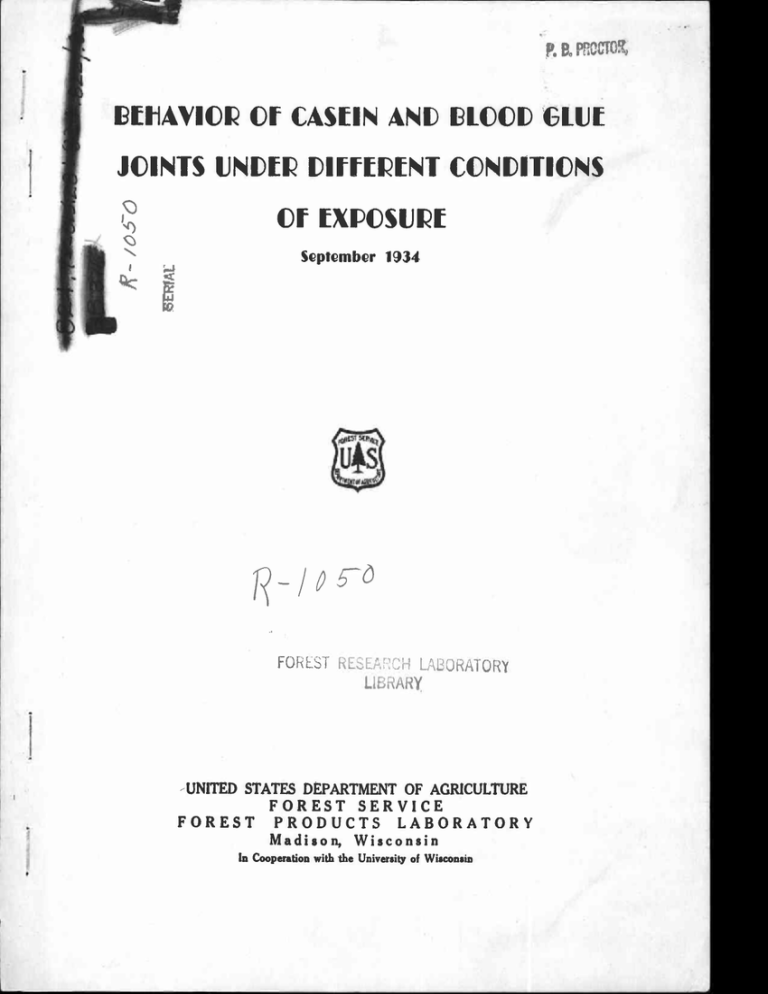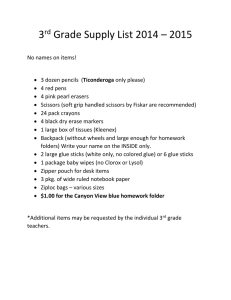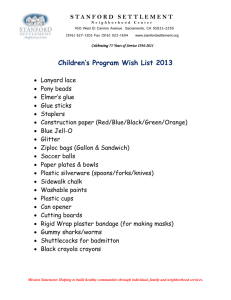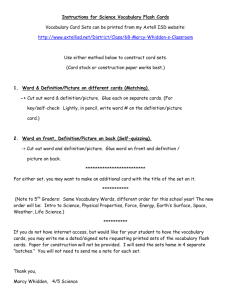N-- p Of CASEIN AND CLOUD Mr sd JOINTS UNDER DIFFERENT CONDITIONS
advertisement

P. a="
Of CASEIN AND CLOUD Mr
JOINTS UNDER DIFFERENT CONDITIONS
Of EXPOSURE
September 1934
N-- p
sd
FOREST RESEARCH LABORATORY
LIBRARY,
-UNITED STATES DEPARTMENT OF AGRICULTURE
FOREST SERVICE
FOREST PRODUCTS LABORATORY
Madison, Wisconsin
In Cooperation with the University of Wisconsin
BEHAVIOR OF ckniN AND BLOOD GLUE JOINTS UNDER
DIFFERENT . CONDITIONS OF EXPOSURE!
By DON BROUSE, Assistant Engineer
Introduction
Glued wood joints that have been properly made with good glues
should last indefinitely under dry conditions and some water-resistant
casein and blood glue joints will last for considerable periods of time
under damp or alternately wet and dry conditions before final failure.
The experiments described in this article were part of a study that has
as its objective making glued wood products as durable as solid wood
croducts for outdoor service.
Continued experience on the part of the staff of the Forest
Products Laboratory with commercial gluing, supplemented by laboratory
tests, has indicated that good glue joints made with blood or casein
glues may fail from any one or any combination of at least three causes:
1.
2.
organisms.1
Chemical hydrolysis of the protein.
Destruction of the protein material in the glue by micro-
3. Mechanical stresses set up on the glue joint by the plies
as they change dimensions under the influence of changes in moisture content.
In order that the relative importance of the different causes
might be more clearly demonstrated the following tests were conducted:
Test Procedure
Well'made plywood specimens of approximately equal strength
were exposed to the following conditions:
a. Continuous soaking in water at room temperatures to
eliminate all factors but chemical hydrolysis.
–Published in Furniture Manufacturer, Sept. 1934: Wood Products, Oct. 1934.
2
–Sutermeister -- Casein and Its Industrial Application. 169-219, Chemical
Catalog Co., 1927.
;rouse -- Increasing the Durability of Plywood. Mechanical Engineering,
V.53,
R 105 0
664-6, Sept. 1931.
b.
Continuous exposure to 97 percent relative humidity at a
temperature of BO° F. to provide a condition favorable
to mold attack and to a certain degree of hydrolysis.
c.
Alternating cycle of 2 days soaking followed by 12 days
drying at 30 percent relative humidity, a cycle providing
high mechanical stresses and only a slight degree of
hydrolysis.'
d.
Alternating cycle of 2 weeks at 97 percent relative humidity
followed by 2 weeks at 30 percent relative humidity to
provide high mechanical stresses, mold action during onehalf of the cycle, and probably a degree of hydrolysis.
Three glues were employed in the tests; namely, “) a casein glue
of low alkalinity (Forest Products Laboratory formula 11),2 (2) a casein
glue of high alkalinity (casein-lime-sodium fluoride), and (3) a bood glue
(Forest Products Laboratory paraformaldehyde formula hot pressed)-ft
One hundred and fifty panels 12 inches square were glued with
each glue, using 3-plies of 146-inch yellow birch veneer. The veneer
was in equilibrium with 60 percent relative humidity before gluing (at
a moisture content of about 11 percent) and after gluing the panels were
seasoned for 10 days at the same relative humidity before cutting them
into test specimens. Thirty standard plywood test specimens_ were cut.
Of the thirty specimens from each panel, five were tested for strength
when dry and five were tested wet after soaking for 4g hours in water at
room temperature. These preliminary tests served as a basis for discarding defective panels and for computing average strength values,
later referred to as control values, that would indicate the original
wet strength and original dry strength of the glue joints. After completing preliminary tests and discarding defective panels 270 specimens for
each glue were arranged as follows for the tests described in this article:
60 for continuous soaking.
90 for continuous exposure to 97 percent relative humidity.
6o for the repeating cycle involving 2 days soaking followed
by 12 days drying at 30 percent relative humidity.
60 for the repeating cycle involving 2 weeks at 97 percent relative
humidity followed by 2 weeks at 30 percent relative humidity.
Strength tests were made at intervals as indicated in the
accompanying table over a period of 3 years. Five specimens were tested
at each interval from each exposure of each glue and the figures in the
table, therefore, are averages of 5 test specimens.
'Gluing Wood in Aircraft Manufacture, by T. R. Truax. U. S. Dept. of Agr.
Tech. Bul. 205. 1930. (Out of print)
R1050
-2-
Results and Discussion
A summary of the results is shown in the accompanying table
and curves. To facilitate comparison each average test value from the
table has been computed as a percentage of the control value and plotted
accordingly in the curves.
Soaking Continuously
•
The durability of the joints under continued soaking was surprisingly high. After 3 years the joints made with blood glue retained
67 percent of their original dry strength or about 81 percent of the
original wet strength. Joints made with the low • alkaline casein glue
remained in test for 28 months before total failure while the joints
made with the casein glue of higher alkalinity failed in 15 months.
The results support the view that chemical hydrolysis of the
protein is the most important factor in the destruction of water-resistant
' protein glue joints under continuous soaking. The casein glue of high
alkalinity failed most rapidly, the casein glue of low alkalinity failed
more slowly, and the ejoints made with the paraformaldehyde blood glue (hotpressed) were still intact after 36 months. Presumably, adding paraformaldehyde as a part of the blood glue formula, together with hot pressing, alters
the nature of the protein in blood in such a way that it hydrolyzes very
much more slowly than the protein present in a casein glue.
Mechanical stresses on the glue joint caused by alternate swelling and shrinking of the wood could scarcely have been a factor in this
group of tests. The plywood was completely and continuously submerged
and the wood, having passed the fiber-saturation point early in the soaking period, remained in an expanded condition and constant in dimension.
The weakening of the joint due to the initial swelling was reflected in
the decrease in strength of the specimens tested after 2 days soaking.
The increase in joint strength noticed between the second and the sixteenth
day of soaking may be due to an adjustment of the glue to the stresses set
up by the initial swelling. Loss in strength, presumably due to hydrolysis,
became noticeable after about 2 weeks of soaking.
Pathological tests indicated that the action of micro-organisms
was of little importance in this group of tests. Gels of casein glue were
submerged in lake water in which the specimens were soaked. As the glue
gel slowly decomposed, cultures were made from time to time, but no increase of micro-organisms could be detected. The number present at any
time was insignificant. Cultures were made from glue in joints that had
then been soaking for 16 months and practically no organisms of any kind,
molds, bacteria, or yeast, could be detected, Cultures from the water in
which the specimens were soaked indicated a large number of bacteria,
but an insufficient number of molds and yeasts to Cause serious damage
to glue. The evidence indicated, therefore, that the probable cause of
failure under continuous soaking was chemical hydrolysis of the glue itself and that if joints are to resist prolonged and continuous soaking,
the glue should be highly resistant to chemical decomposition.
R 1 050
-3-
Continuous Exposure to High Humidity
The results of continuous exposure to 97 percent relative
humidity strongly supported the view that untreated glue joints Tail
under this type of exposure mainly because of attack by micro-organisms.
The joints made with the casein glue of low alkalinity failed just as
rapidly as joints made with the highly alkaline casein glue and both
failed more rapidly than did the joints made with either glue and soaked
continuously. Previous tests/ had demonstrated that resistance to attach
by micro-organisms when continuously exposed to dampness could be
greatly improved by treating with toxic agents yet the same toxic
agents in the continuous soaking tests did not retard failure due to
chemical hydrolysis. It is conceivable that plywood might be treated
with sufficient toxic material to prevent the development of mold and
yet fail ultimately, in very damp exposures, because of hydrolysis of
the glue. Mechanical stresses could be of only minor importance under
this condition of exposure since the wood, after reaching equilibrium
with the damp atmosphere, remained constant in dimension except for
{ slight changes due to minor variations in the humidity of the atmosphere.
,The outstanding durability of the joints made with blood glue
may be explained by the fact that the blood glue contained paraformaldehyde as a part of the formula. The amount of paraformaldehyde present
was probably sufficient to prevent mold attack on the glue line, but it
did, not prevent fungus attack on the wood. Rotting of the wood was
clearly evident at the end of the eighth month. The decrease in strength
in the blood glue joints after the eighth month, therefore, was probably
due to weakening of the wood rather than to destruction of the glue.
So far as this group of tests is concerned, the destruction of
the glue line by molds or the destruction of the wood by fungi was the
primary cause of failure. Increasing the resistance of plywood to continued exposure to high humidity can be accomplished readily by impregnating with material toxic to molds and fungi.
Alternate Soaking and Drying
In the repeating cycle of 2 days soaking followed by 12 days at
30 percent relative humidity, all specimens, even those glued with the
highly water-resistant'blood glue, had failed completely by the end of
25 months, Specimens glued . with casein glue had failed by the end of 13
months. The conditions of this exposure are not favorable to mold growth
so that it may safely be assumed that molds contributed little to the
destruction of these joints. Chemical hydrolysis may have contributed
slightly to failure, 'A continuous soaking test, however, offers a better
condition for .hydrolysis than soaking and drying and yet the joints
were much more durable when soaked continually than when alternately
soaked and dried. Mechanical stresses, therefore, appeared to be the
pain cause of failure in this group of tests. The drying period is believed to be particularly damaging to the joints. The plies dry and
begin to, shrink while the'
is still in the swollen and weakened
state from the soaking; the result is an early opening of the glue joint,
the failure appearing first, of course, at the edges of the specimens.
R1050
Minor changes in glue formulation cannot be expected to increase durability under such severe conditions of test. The low alkali
casein glue failed even more rapidly than the higher alkali type, but the
difference was not considered significant. Even the use of blood glue
that differs widely from the casein glues failed to produce the durability
desired although the blood glue joints lasted longer than the casein glue
joints. It is probable that the blood glue softened less than the casein
glue in the 2 days soaking and was less readily damaged by the subsequent
shrinka7e stresses in the low humidity part of the exposure cycle.
If plywood is to prove permanently durable under such severe
cyclic changes marked improvement must be made in the glue or the shrinking and swelling of the wood must be modified. The former, at present,
appears the most likely to be accomplished.
Alternating High and Low Humidity
The repeating cycle of 2 weeks at 97 percent relative humidity
followed by 2 weeks at 30 percent relative humidity provided conditions
favorable to mechanical stresses and moderately favorable to mold action.
Since chemical hydrolysis appears to have been of little importance under
continuous exposure to high humidity, it probably was not an important
factor in this test.
Certainly mold action was a factor, for the specimen gave clear evidence of the development of molds and other fungi.
Mechanical stresses must be considered of major importance for the plywood changes in moisture content from roughly 25 percent at 97 percent
relative humidity to about 7 percent at 30 percent relative humidity.
For this type of exposure it appears important to have a glue that first
of all withstands mechanical stresses and secondly resists mold attack.
If these properties are provided then hydrolysis might become a factor
that would cause final failure unless the chemical action was also
avoided.
Summary
The permanence of plywood glue joints under all conditions
of service depends upon control of the three principal causes of failure, namely, chemical hydrolysis, mold action, and mechanical stresses.
The method of control must be varied in accord with the particular conditions of exposure. Mold action may be reduced by the use of preservatives, hydrolysis by selecting glue that does not hydrolyze in the
presence of moisture. Neither method, however, assures that plywood
will remain durable when exposed to alternating periods of wetting and
drying. Gluing wood for successful exposure of such conditions apparently
requires a glue that does not soften appreciably in water, but retains
practically full strength whether wet or dry.
81050
- 5-
Effect of type of exposure on durability of plywood glued with casein
or blood albumin glue.
Time of
exposure
:Casein glue of low: Casein glue of :
higher alkalinity:
alkalinity
(F.P.L.
: (sodium fluoride-:
formula 11)
: casein lime)
•
None (dry control):
None (wet control):
Blood glue
(F.P.L. paraformaldehyde
hot pressed)
Pounds per square inch=
409
361
343
196
342
255
Soaked continuously
2 days
S days
16 days
1 month
2 months
3 months
5 months
10 months
15 months
20 months
25 months
36 months
299
246
257
219
201
181
174
15
140
152
105
2 •
0(28) — •
Exposed continuously to
1 month
2 months
4 months
S months
12 months
16 months
20 months
24 months
30 months
36 months
•
.
.'
•
279
65
72
2
0(8)—
34o
377
384
160
187
196
180
165
139
134
30
0
•
•
o
0(20)2—
302
340
323
291
317
294
274
2SS
276
97 percent relative humidity
132
22
4o
o(S)2
379
330
328
313 3.
270
248
224
216
169
135
Exposed to repeating cycle: 2 days soaking -- 12 days
at 30 percent relative humidity
1 month
3 months
6 months
12 months
18 months
24 months
36 months
309
2og
,
57
o(7)E
311
252
127
26
0(13)?
337
262
265
209
99
36
o(25)E
(oontinued on next page)
R1 05 0
1
Effect of type of exposure on durability of plywood glued with casein
or blood albumin glue (continued).
Time of
exposure
:Casein glue of low: Casein glue of : :
: higher alkalinity:
alkalinity
(sodium fluoride-:
(F.P.L.
formula 11)
:
casein lime)
•
Blood glue
(F.P.L. paraformaldehyde
hot pressed)
1
Pounds per square inchnch–
Exposed to repeating cycle: 2 weeks at 97 percent -- 2 weeks
at 30 percent relative humidity
343
1 month
298
324
346
3 months
00
166
380
0
6 months
:
75
249
0(17)–
12 months
830(15)–2 ::
274
18 months
275
24 months
203
36 months
•
1
–Other than control averages, each value is an average of 5
-Time in months at which last specimen failed.
Wood rot in evidence.
R1050
specimens.
4
100
75
.
•
50
•
Boo
o'
1111 SOAKED CONTINUOUSLY IN WATER
--."- °° GLUE
- •
..01
25
CAS /N GLuE
III
-..p..........-4.1111111.11illiiiii illiiiiiiiiii
n
- -111111•01111111.111M ,
i-°- '--0.°/047
, _.Z 00,9,4ie
_
cw M
In
•
."
:Z/ME - CASEIN
n
0
1k
/00
v 75
soniii
•
EXPOSED CONTINUOUSLY TO 97 PERCENT RELATIVE HUMIDITY
_ is _ -BLOOD
GLU "_
opinim
1:4 50
=II
tom
L+4
S00/UM
1
rt 0
25
FLUOR/OE-LIME-CASEIN GLUE
n
11111111111111
n
nn
4.1
14, 100
LLJ
•
75
•
5
EXPOSED TO A REPEAT/NG CYCLE:- 2 DAYS SOAKING FOLLOWED
/2 DAYS AT 30 PERCENT RELATIVE HUMIDITY
I.
k
il
1116
191
1"11. 111111111111
°4- / 00
7
5
2
n
no immili
-9 -.
!NM
CASE/N CLUE
III
III
1.
k SOP/UM
0
n
III
EXPOSED ro A REPEATING CYCLE:- 2 WEEKS AT 97 PERCENT RELATIVE
HuM/DITY FOLLOWED BY 2 WEEKS AT 30 PERCENT RELATIVE Hum/DITY
-111:11
BY
2
22 825v
4
FLUOR/PE-LIME 7 CA
6
8 10 /2 14 /6 15 20 22 24 26 28 30 32 34 36 38
TIME OF EXPOSURE (MONTHS)
BEHAVIOR OF PLYWOOD GLUED WITH CASE/N OR BLOOD GLUE
WHEN TESTED UNDER DIFFERENT CONDITIONS OF EXPOSURE








